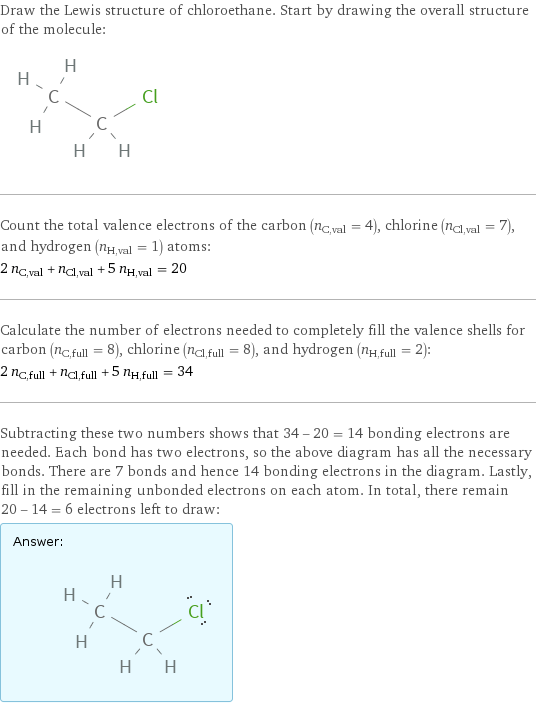Input interpretation

chloroethane
Chemical names and formulas

formula | C_2H_5Cl name | chloroethane alternate names | ethyl chloride mass fractions | C (carbon) 37.2% | Cl (chlorine) 55% | H (hydrogen) 7.81%
Lewis structure

Draw the Lewis structure of chloroethane. Start by drawing the overall structure of the molecule: Count the total valence electrons of the carbon (n_C, val = 4), chlorine (n_Cl, val = 7), and hydrogen (n_H, val = 1) atoms: 2 n_C, val + n_Cl, val + 5 n_H, val = 20 Calculate the number of electrons needed to completely fill the valence shells for carbon (n_C, full = 8), chlorine (n_Cl, full = 8), and hydrogen (n_H, full = 2): 2 n_C, full + n_Cl, full + 5 n_H, full = 34 Subtracting these two numbers shows that 34 - 20 = 14 bonding electrons are needed. Each bond has two electrons, so the above diagram has all the necessary bonds. There are 7 bonds and hence 14 bonding electrons in the diagram. Lastly, fill in the remaining unbonded electrons on each atom. In total, there remain 20 - 14 = 6 electrons left to draw: Answer: | |
3D structure

3D structure
Basic properties

molar mass | 64.51 g/mol density | 0.765 g/cm^3 dielectric constant | 1.013
Thermodynamic properties

specific heat capacity c_p | gas | 0.9735 J/(g K) | liquid | 1.617 J/(g K) molar heat capacity c_p | gas | 62.8 J/(mol K) | liquid | 104.3 J/(mol K) specific free energy of formation Δ_fG° | gas | -0.9363 kJ/g | liquid | -0.9192 kJ/g molar free energy of formation Δ_fG° | gas | -60.4 kJ/mol | liquid | -59.3 kJ/mol specific heat of formation Δ_fH° | gas | -1.738 kJ/g molar heat of formation Δ_fH° | gas | -112.1 kJ/mol molar heat of vaporization | 25.3 kJ/mol | specific heat of vaporization | 0.3922 kJ/g | molar heat of fusion | 4.45 kJ/mol | specific heat of fusion | 0.069 kJ/g | (at STP)
Chemical identifiers

CAS number | 75-00-3 PubChem CID number | 6337 PubChem SID number | 24857739 SMILES identifier | CCCl InChI identifier | InChI=1/C2H5Cl/c1-2-3/h2H2, 1H3 MDL number | MFCD00000961
Safety properties

flash point | -40 °C
Toxicity properties

short-term exposure limit | 3250 mg/m^3 threshold limit value | 100 ppmv

long-term exposure limit | 2600 mg/m^3 (over 8 hours)